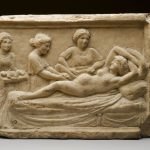Chapters
In ancient Rome, midwives (obstetrices) played a key role in society, being not only specialists in the field of obstetrics but also women’s guides in one of the most important moments of their lives – the birth of a child.
The role and importance of midwives
Midwives were widely respected in Roman society because they oversaw labour and assisted with births. The knowledge they possessed was often passed down from generation to generation, and these women learned both from older, experienced midwives and through practice. In many cases, midwives did not limit themselves only to childbirth issues – they also dealt with basic care for the health of women and newborns.
The most qualified midwives could enjoy great recognition and independence. Often, their skills were invaluable, especially in wealthy families that could afford the care of one experienced obstetrix. There are testimonies in the literature about midwives working both in private homes and in larger centres such as baths and temples.
Cooperation with doctors
Even though midwives were mainly independent specialists, they cooperated with contemporary doctors, especially in more difficult cases. They often accompanied doctors who were responsible for more complicated procedures. Some midwives, like Roman physicians, used medical writings and treatises that explained childbirth procedures and techniques.
For example, Soranus of Ephesus, a Greek physician operating in Rome, wrote the medical treatise Gynaikeia in which he described the ideal midwife as an intelligent woman with good manual skills and the ability to keep calm in stressful situations. He also recommended that midwives be women who had given birth themselves because personal experience was considered valuable knowledge.
In Soranus we find a mention that midwifery was not reserved exclusively for midwives. The male doctor could also deliver babies in exceptional situations. However, the sources leave no doubt that births were performed primarily by midwives.
Traditions and superstitions
In the ancient world, childbirth was not only a medical but also a spiritual event. Midwives were familiar with various magical and religious practices. It was believed that appropriate prayers and rituals could ensure safe childbirth and the health of the newborn. Amulets and herbs were often used to bring good luck and protection to both mother and child.
Some midwives were also priestesses of goddesses associated with birth and motherhood, such as Juno Lucina‘s goddess of birth, motherhood, and women. Lucina was revered by women throughout Rome, and midwives often invoked her name during childbirth.
Midwives in literature and historical sources
Much of the knowledge about Roman midwives comes from medical literature and archaeological records. Fragments of medical treatises, such as the writings of the aforementioned Soranus, provide information on obstetric techniques and requirements for midwives. In Roman literature, such as the writings of Plautus and Tacitus, there are figures of midwives who show their influence on the everyday lives of Roman women.
Epitaphs and inscriptions on tombstones also testify to the respect given to midwives. Some tombs have dedications that highlight not only their midwifery skills but also the personal bond they established with their families. Numerous tomb reliefs depicting the birth of a child have also been preserved.







